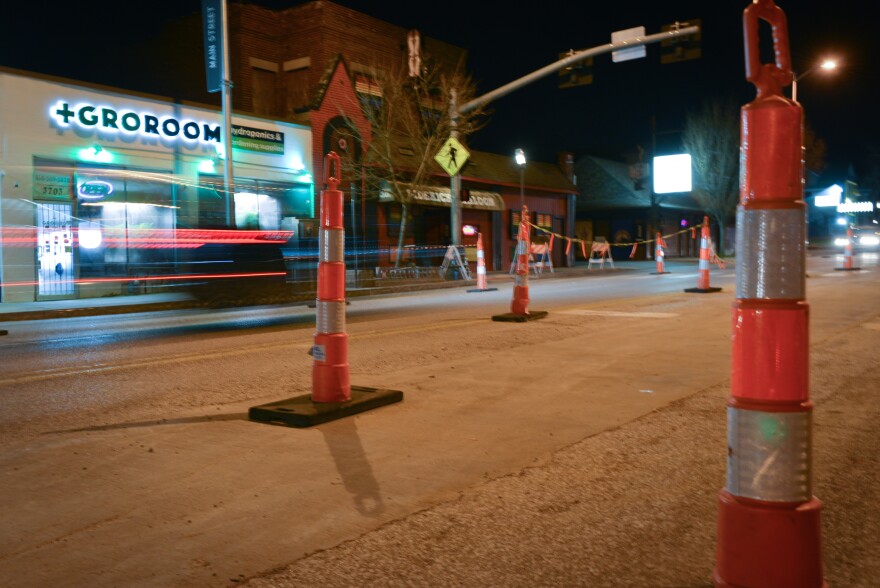Darren Matheson peered through the large plate-glass windows of Happy Rock Farms along Main Street near 38th Street. The humidity from his gardening store suspended a thin film of moisture on his windows, making the orange pylons on Main Street appear like blurry soldiers marching in the mist.
“The cones out here have been in the same spot for months,” Matheson said. “They’ve changed the pattern of the traffic a little bit, but it’s still, it’s painful either getting in or it’s painful getting out.”
“You talk to our customers,” he continued. “They don’t want to navigate down Main.”
Happy Rock Farms has been in its location for almost three years. Matheson estimated he has lost 40 to 50% of his business because of the combined hit of the pandemic and street construction.
“We don’t know if we can stay in this area because it’s really not been fruitful,” Matheson said. “We’ve seen a decrease in business over the past few months just as they started digging.”
Kansas City and private companies have spent the last year on and around Main Street tearing into the pavement, replacing or upgrading utilities, adding new fire hydrants and rerouting traffic. For each patched hole, a new one sprouts up.

It’s a $351 million endeavor, and a massive frustration for local business owners — all to lay 3.5 miles of rail for the KC Streetcar to run between Union Station and UMKC.
And those rails are still far in the future. The streetcar is not scheduled to make its first run until 2025.
What’s next for Main Street
As of late December, a spokeswoman for Kansas City Public Works said that both water line work and private utility upgrades have nearly been completed, but sewer upgrades are just beginning.
In January, some prep work on the actual infrastructure for the streetcar will begin, and a groundbreaking will be held in the spring.
“Sewer upgrades will be pretty massive. Those are very large pipes,” said KC Streetcar spokesperson Donna Mandelbaum. “It will be very similar to what you see out there except you won’t have 15 different utilities working in the same hole as the sewer.”
That future work will still come with the price of more lane closures, detours, and rerouting of vehicle and pedestrian traffic. But project leaders say that driving on Main Street should be better in the new year — somewhat.

Kansas City recently implemented a traffic control policy that is meant to alleviate drivers’ frustrations with road work around the city. According to the policy, which took effect in December:
- Traffic control devices are to be removed after 48 hours if work is not actively underway.
- Open excavations should be covered with steel plates and should be embedded and level in the pavement.
- Other traffic control devices should not be placed more than 300 feet from a work site and not on side streets.
What business owners want
Jennifer Ferguson, owner of Boogie’s Midtown Tavern, said the construction is a hassle but she’s looking forward to the opportunities the streetcar will bring.
“I don't want my customers driving,” she said. “I'd prefer them to be able to take the streetcar.”
Ferguson also said something several other Main Street business owners repeated: Her regular customers are not deterred by the traffic. They will come no matter what. But she does worry about their safety.
“I fear for some of my customers when they're driving home,” she said. “Things change that you’re not used to.”
Maggie Green of Kansas City Public Works said the city understands the frustration of business owners.
“We know that this is a bittersweet process,” she said. “This is very frustrating and challenging while we’re in the middle of it for the businesses, for the people driving along Main Street and people walking along Main Street.”
Green said the city was prepared for a mixed response to the construction. They placed signs on the corridor alerting people to businesses that are open, and added business owners and other stakeholders to mailing updates for Upgrades on Main.

But Alex Sommerkamp, who manages Gro Room at the intersection of East 37th and Main, said he isn’t aware of those outreach efforts.
Since construction began, Sommerkamp said, he’s seen an increase in accidents and a decline in business.
“Every time we go outside, we see someone driving on the wrong side or swerving into the construction area,” he said. “And there’s nowhere to park.”
New customers particularly struggle with the construction.
“They are more likely to avoid coming in all together because there’s not an easy place to park,” he said.
Sommerkamp tells his existing customers “strategically” where the best parking spots are.
“But dragging bags of soil across a very busy street to get to someone’s car is not an easy endeavor,” he said. “In New York, people will carry all kinds of things on the subway, so it’s very likely some will not care, but others will avoid it all together.“
Even still, Sommerkamp said he’s optimistic about the future of the streetcar on Main Street.
“I’m hopeful that it’ll be worth it in the end,” Sommerkamp said. “We’ll see how it affects our business in the next couple of years. But we’re here to stay as far as I’m concerned.”





